Disk Tumbler Locks
Combination or “puzzle” locks were invented to further improve security and the protection of valuables. The older safes and lockboxes were good security devices when they came into the market, but some people became curious and realized that these safe locks had inherent weaknesses. One of the main problems was that the disk tumblers were not mechanically isolated from the bolt that unlocks the safe door. In other words, you could feel and hear the tumblers while turning the dial by applying pressure on the handle of the bolt.
When that problem was recognized and solved, thieves started drilling through strategic places in the lock itself to open it. Knocking off hinges was an all-time favorite tactic as well. Then came punching out the dial shaft, blowtorching, and just plain blowing the door with explosives. Greed can breed great creativity.
The first problem, that of manipulating the tumblers open, was rectified by making use of the dial to operate the bolt upon completion of the dialing of the correct combination. This made it nearly impossible to feel or hear the tumblers. Drilling was deterred by laminating the safe door with hard steel and beryllium-copper plates. The beryllium-copper plates pull heat away from the drill tip quickly, and the bit just spins without effect; drilling cannot take place without the generation of heat at the bit’s cutting edges. Knocking off hinges was discouraged by using three or more bolts operated by a main linkage network. Punching out the dial shaft to let the tumblers fall out of the way of the bolt was corrected by beveling the shaft into the wall of the safe door.

Figure 31. A disk tumbler safe lock.
Presently, safe locks are quite sophisticated. Picking them would require supernatural power. The older safes, however, are much easier and even fun to pick. Picking combination padlocks is a good way to start learning how to open safes, and we will get to them shortly. But first, let us discuss some basic principles of disk tumbler locks.

Figure 32. Here is a modern disk tumbler dial system (top), and a set of disk tumblers (above).
Disk tumbler locks work by the use of flat, round disks of metal or plastic with a notch and a peg on each disk. The notch is called the tumbler gate. The gate of each tumbler has to be lined up with the pawl of the bolt mechanism by usage of the linking capabilities of the pegs.
The first tumbler of the disk tumbler lock (also the last combination number dialed) is mechanically connected to the dial through the safe door. When the dial is turned, the first tumbler picks up the middle tumbler when their pegs connect. The middle tumbler in turn picks up the last tumbler for one more complete turn and the tumblers have been “cleared”—you are ready to dial the first combination number by aligning the last tumbler s gate to the pawl. After you have reached this number or position, rotate the dial in the opposite direction one complete turn (for three tumbler locks; two turns for four tumbler locks) to engage the middle tumbler and drive it to the second combination number. By rotating the dial back into the opposite direction to the last combination number, the bolt can be operated to open the lock, or as in the case of newer safes, the dial will operate the bolt by turning it once again in the opposite direction.
One of the innovations that developed to deter sensual manipulation of combination locks was the use of serrated front tumblers (last combination number dialed). These were designed to foil listening and feeling of the tumblers’ gates by burglars.

Figure 33. A serrated disk tumbler.
When the bolt encountered any one of these shallow gates, the safecracker could never be sure whether or not a tumbler was actually aligned with the pawl-bolt mechanism. Some burglars solved this problem by attaching high-speed drills to the dial knob to rotate and wear down the first tumbler’s shallow false gates against the bolt, thereby eliminating them altogether, or at least minimizing their effects. Still, today the serrated tumbler is used as an effective deterrent to manipulation in combination padlocks where space is a factor.
Let us move on to combination padlocks. The most common and difficult to open of these small disk tumbler locks are the Master combination padlocks, and they are quite popular. I have had good luck in opening these locks with a wooden mallet or soft-faced hammer. The manipulation of Master combination padlocks is quite easy—I have done it thousands of times, and you can learn it, too. The newer the lock is, though, the more difficult it will be to open at first. If the lock has had a lot of use, such as that on a locker-room door where the shackle gets pulled down and encounters the tumblers while the combination is being dialed, the serrated front tumblers will become smoothed down, allowing easier sensing of the tumblers. So, until you have become good at opening these locks, practice extensively on an old one. Let’s try to open one:
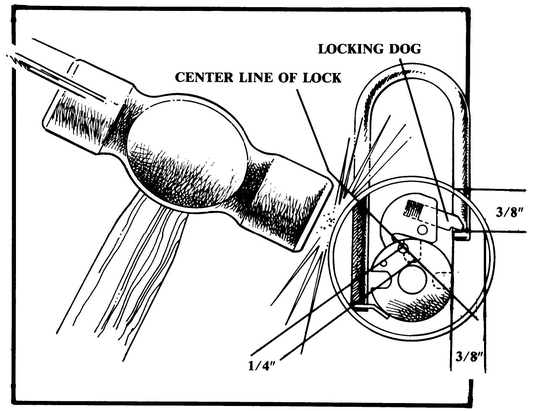
Figure 34. The simplest technique for opening combination locks.
OPENING A COMBINATION PADLOCK
STEP ONE
First, clear the tumblers by engaging all of them. This is done by turning the dial clockwise (sometimes these locks open more easily starting in the opposite direction) three to four times. Now bring your ear close to the lock and gently press the bottom back edge to the bony area just forward of your ear canal opening so that vibrations can be heard and felt. Slowly turn the dial in the opposite direction. As you turn, you will hear a very light click as each tumbler is picked up by the previous tumbler. This is the sound of the pickup pegs on each disk as they engage each other. Clear the tumblers again in a clockwise manner and proceed to step two.
STEP TWO
After you have cleared the tumblers, apply an upward ing tumbler (last number dialed). If you hear and feel only one hollow click (sounds like “dumpf”), chances are that the first number could be the same as the last one.
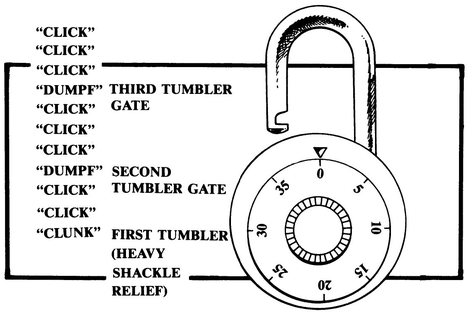
Figure 35. Listen carefully for the real gates when opening the combination padlock.
You should have two numbers now. Let us say one of them is 12 and the other is 26. Clear the tumblers again just to be safe and stop at the number 12. Go counterclockwise one complete turn from 12. Continue until there is another “dumpf” sound. After the complete turn pass 12, if you feel and hear a louder than normal sound of a tumbler rubbing on the pawl, the first tumbler is properly aligned and the second tumbler is taking the brunt of the force from the shackle—you are on the right track. When the second tumbler has aligned in this case, you will feel a definite resistance with the last turn of the dial going clockwise. The final turn will automatically open the shackle of the lock. If none of these symptoms are evident, try starting with the number of the combination, 26, in the same way.
STEP FOUR
If the lock still does not open, don’t give up. Try searching for a different first number. Give it a good thirty- or forty-minute try. If you play with it long enough, it will eventually open. The more practice you have under your belt, the quicker you will be able to open these padlocks in the future.
Using a stethoscope to increase audibility of the clicks is not out of the question when working on disk tumbler locks, though I never use them for padlocks. A miniature wide-audio-range electronic stethoscope with a magnetic base for coupling a piezoelectric-type microphone is ideal for getting to know the tumblers better.
Filing your fingertips to increase sensitivity might not be such a good idea for beginners since their fingertips will not be accustomed to operating dials for a long period of time. With practice, you may develop calluses and need to file your fingertips. But I don’t recommend it at first.
After some time you may find that in some cases you can whiz right through the combination of an unknown lock without looking at it and pop it open in seconds. It becomes second nature. I’ve done this on many occasions—something beyond my conscious control seems to line up the tumblers without my thinking about it.
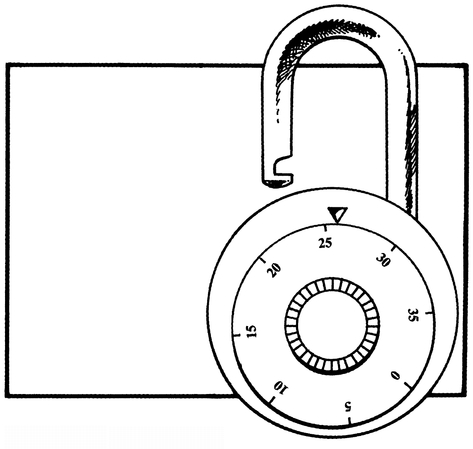
Figure 37. The padlock is open.
Another type of disk tumbler padlock is the Sesame lock made by the Corbin Lock Co. Its unique design makes it more difficult to open than Master padlocks, but it can be opened. Let’s take one of the three or four wheel mechanisms, look at a cross section, and see how it works. The wheel has numbers from zero to nine. Attached to the wheel is a small cam. Both the wheel and cam turn on the shaft. Each wheel in this lock operates independently with its own cam and shaft. The locking dog is locked to the shackle. In this position the shackle cannot be opened. The locking dog operates with all three or four wheels. The locking dog is riding on the round edge of the cam. The spring is pushing up on the cam. The locking dog cannot move up because it is resting on the round part of the cam. When the wheel is turned to the proper combination number, the locking dog rests on the flat of the cam. The spring can then raise the locking dog to release the shackle, and this opens the lock.
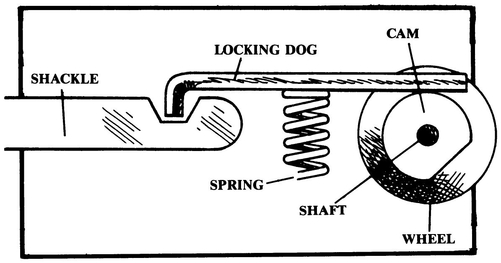
Figure 38. The Corbin Sesame padlock has a complicated opening mechanism.

Figure 39. But the Sesame padlock can be manipulated open.
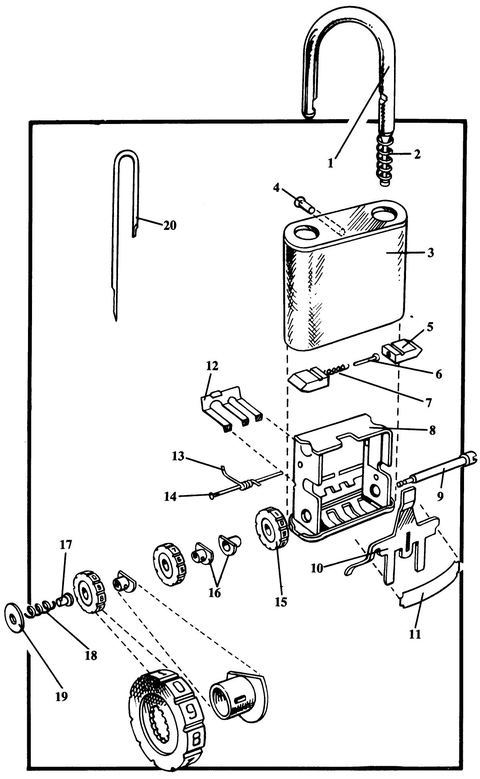
Figure 40. The Corbin Sesame padlock. 1: shackle; 2: shackle spring; 3: case; 4: rivet; 5: bolts; 6: alignment pin; 7: bolt spring; 8: housing; 9: wheel shaft; 10: dog plate; 11: anti-vibrator spring; 12: stop lever plate; 13: spring for dog plate; 14: spring pivot pin; 15: wheels; 16: slide bearing (cams); 17: bearing; 18: pressure; 19: lock nut for wheel shaft; 20: change pin.